Posted on October 4, 2006
Molly Pitcher, Toynbee tile
Yesterday, I mentioned that my girlfriend often asks why I’m so distrustful of ruralites. Today I come to you with a different question she often asks me, why do I care about the Toynbee tiles.
I don’t actually understand the question. How could I not care? First off, they’re a Philly mystery. Secondly, they’re laid in the dead of night, have a strange and esoteric message, are created and presented on a completely unique medium, and (having spread all over the country and even the hemisphere) are a tremendous success. The person behind them takes no credit for them, the idea being the only reason for their existence. Beyond even this, they’re conspiratorial, sci-fi inspired and beautiful pieces of art. Finally, the mystery is incredibly fun to research, with bizarre plot turns and magical coincidences occurring with such starting frequency that my very ideas regarding the fabric of the universe and of life itself are often solidified and sometimes even shaped by the process of this research.
That’s all what interests me about them.
But anyway, one of these ‘coincidences’ took place the other night on a trip back from Connecticut. The Resurrect Dead team successfully filmed the solitary new school tile beyond the Philadelphia area. For some reason it was glued at exit 55 off I-95 in Connecticut. But while finding out about that tile was a coincidence in itself, it’s not the magic thing I’m talking about.
On the way home, we stopped at a New Jersey rest area a little over an hour from Philadelphia. I was absolutely certain there was a tile there. Now maybe I saw this tile on one of my many trips up the Jersey Turnpike sometime in the last decade. Maybe the tile at Molly Pitcher rest area was buried somewhere deep in my subconscious. But my certainty felt more like intuition than subconscious knowledge. (assuming there’s a difference between the two…)
You can say that tile research requires you to tune into some bizarre frequency. (probably somewhere around 6.25 megacycles) At any rate, Molly Pitcher rest area felt very, very right. To quote Colin, I searched the place “like a drug-sniffing dog in Colombia” but found nothing. As we started to pull out, my eyes were trained on something that looked like a fast food bag crushed into the pavement. As we passed over it, I saw that it was actually a fractured old-school tile. Of course we had to stop and film the thing. Here are a few photos of that discovery.
 |
 |
 |
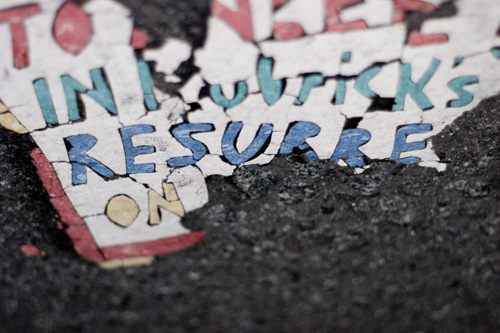 |
Posted on September 23, 2006
National!
I missed the broadcast, but this morning NPR’s Morning Edition ran the Toynbee tile story. The story was aired across the country and around the world. A text version is currently on the NPR.org‘s front page. Audio will be available later today. Sweet!
Posted on September 13, 2006
new, new style tiles made in new style appearing west of broad
Yes, you read that right. This morning I noticed a new Toynbee tile at 19th and Chestnut. It’s made in the new style, but in a new style for the new style. These new, new style tiles are larger, appear to be more carefully made, contain possible new messages and are placed farther into the street than the old, new style tiles. This is exciting. When I hit the message board with my astonishing discovery, I saw that reports of new, new style, new tiles have been pouring in since late last night.
Although the tiles were probably laid a week to a month ago, everyone noticed them in the last few hours. Weird. New, new style, new tiles have been spotted at the following locations:
19th and Chestnut
30th and Market
31st and Market
Pictures to follow.
Posted on August 24, 2006
HUGE TILE NEWS
This post is intended for fans of Toynbee tiles. If you’re not a fan, I’m sorry, but there wasn’t a whole lot I could do to make this entertaining reading for you. It’s largely technical and entirely esoteric. However, if you are a fan, this post represents the largest disclosure in Toynbee tile research in a very long time. Revealed herein is new, possibly earth shattering information. Read on.
Classic Toynbee tiles stopped appearing in cities across the country sometime in late 2002 or early 2003. Immediately following the disappearance of the original tiles, several new styles of tile started showing up in Philadelphia streets and on highway exit ramps surrounding the city. Until recently, it was generally believed that these new tiles were the work of a copycat.
The font on the new tiles is different. The material (at least on the smaller ones) seems to be something new and far more brittle. The tiles are placed differently, close to the curb and on highways. They’ve also wandered from center city seemingly following the subway and elevated train lines. New tiles have been spotted at 52nd street, Temple campus, Drexel campus, even in Frankford and the lower Northeast. There are 3 tiles on I-95 near the Linc, and farther north on the same road. There are also several on I-76 and the Blue Route. But that’s where they ended. These new “copycat” tiles never appeared outside of Philadelphia. (For a complete taxonomy of the tiles, click here)
Taken as a whole, all of these facts suggest the work of a copycat. Without getting into too much minutiae, the new tiles don’t appear to be as skillfully crafted as their predecessors and their M.O. seems much different.
But 2 tiles changed all of this. The first was discovered in early June at Cottman & Torresdale in Northeast Philadelphia. The second was found in central Connecticut by a man named Brian Stroehlein. About 2 weeks after the discovery of the NE Philly tile, I read this thread over on metafilter and contacted him. He was nice enough to pull over and get a couple shots of the CT tile with his Nikon D70. The image he sent me represents the first new style tile found outside of the Philadelphia area. Already, this news is very big in the strange little world of Toynbee tile research.
But I think this news is potentially much bigger. The Cottman Torresdale tile shook the tile community. The font on the sidebar sections was extremely close to that of the original tiles. Was this just the work of a copycat working harder to emulate the original, or was it the work of the original tiler? The question hung in limbo until the discovery of the CT tile.
What struck me about this tile (besides its location) was that it was a near exact copy of the NE Philly tile. The emphasis here is on the word ‘near.’ There is 1 very small difference between the tiles. The CT tile contains the message:
YOU MUST LAY TILE YOU!!
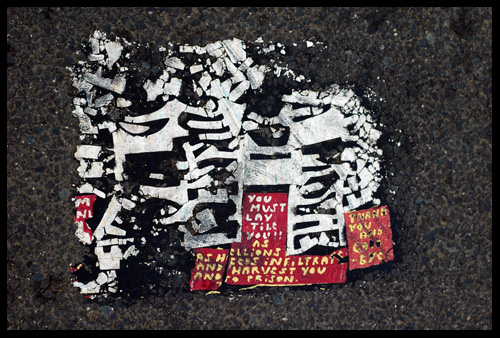
While the NE Philly tile says:
YOU MUST MAKE TILE YOU!! YOU!!
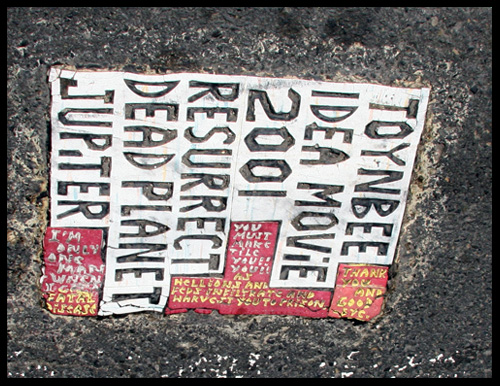
Just a week or so a go a tile at the Broad Street exit of I-95exit was discovered. It too is identical to the other two, except that it says:
YOU MUST TILE!! YOU!
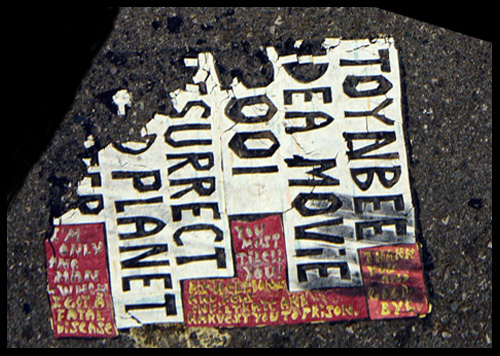
Other than these tiny differences, the tiles are identical. Without revealing anything I am not at liberty to speak of, I have to say that the tiny differences in these otherwise identical tiles strongly suggest that these new school tiles display the very same unique form of obsessive behavior that inspired the originals. If they were exactly the same, I’d say a copycat was banging them out out of a single stencil. That they display extremely minor differences, but are otherwise precise clones suggests that they’re the product of genuine obsessive behavior. Put together with their geographic diffusion and stylistic similarities and I am close to being convinced that these new tiles are the work of the original Toynbee tiler. In short, this is huge news. That’s all for now.
Posted on August 21, 2006
only by destruction of the…
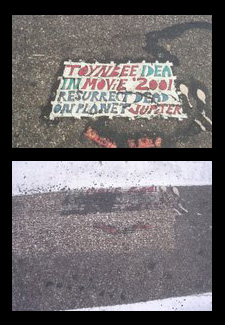 Word out of Chicago is that Toynbee tiles are being actively sought out and destroyed. Is this some sort of Hellion conspiracy against the movement? If it is, the perpetrators aren’t admitting to it.
Word out of Chicago is that Toynbee tiles are being actively sought out and destroyed. Is this some sort of Hellion conspiracy against the movement? If it is, the perpetrators aren’t admitting to it.
“…the Toynbee tiles are vandalism against public property.” Wrote City of Chicago Department of Transportation’s Director of Communications, Brian Steele when asked for a statement. “…But their impact is more than aesthetic. Roadway pavement markings, governed by federal standards, are intended to provide direction to drivers and pedestrians. Any unauthorized pavement markings could be confusing or potentially jeopardize safety. Additionally, installation of the tiles can damage the pavement surface and possibly lead to premature deterioration and additional repair costs.”
So there you have it. Apparently the tiles are too distracting and destructive for Chicago streets. Technically he’s correct about the distracting part (not sure where the studies are that examined the impact of linoleum based mosaic pressed into asphalt, but I would definitely like to read them!) but as distractions go, I’d say they rank pretty low. City streets tend to be distracting. That’s pretty much what defines them. Generally the more distractions you have the better. You got stores and cars and billboards and newsstands and people (many of whom dress to distract) and music and car horns and sirens and colors and lights and all sorts of crazy shit flying around all over the place.
Toynbee tiles are noticed by very few and cared about by even less… unlike say, a 20 by 30’ billboard of a half naked woman stroking a bottle of Smirnoff ice that some slick dude in an open shirt is holding provocatively between his legs while they dance in some shitty fictional nightclub.
But anyway, I accept CDOT’s reasoning – it is their job to do exactly what they did – but I can’t say that I agree with them. It reminds me of those poor assholes whose job it is to chase people out of the fountain at Logan Circle in 100+ summer heat. Yes it says no swimming, but do we really need a full-time guard stationed menacingly in a park-police cruiser solely to enforce a pointless law and snub out an enduring Philly tradition? But I was talking about the tiles.
The tiler reserved his largest and most carefully constructed tiles for the countries largest cities, New York and Chicago. Today there’s only 1 known tile left in New York (possibly after a similar campaign of destruction) and none in Chicago. A tile’s life is finite to begin with. To purposefully remove them seems like a waste of time, resources and tax dollars… not to mention just being a shitty thing to do. O’well. That’s all for now.
Posted on August 16, 2006
New Religion announced/denounced
This morning I sketched out the founding tenet of my personal religion. This doesn’t mean it’s actually my personal belief system, just that it’s the foundation of a belief structure by which others could live. Does this make me a hypocrite? I know it sounds strange to invent a religion and then not be much of a follower of it, so here’s a more detailed explanation:
The truth is, this tenant is something I thought of this morning as I was brushing my teeth and reading the personal letters of the Columbine killers. I’m just not sure I want to convert yet. Secondly, I’m wary of any religion, even my own. Lastly, this founding tenant is based on an amalgam of established religious belief structures, none of which I necessarily assign any credibility. But from a cultural standpoint, this tenant goes a long way in explaining the world we live in and I’m sure I can gain some following… even if I’m not among them. I also think that it’s strong enough conceptually to share and therefore would like to present it.
Basically, I came to the conclusion that power is corrupt. On the flip side of things, power is an incredibly effective tool that guarantees results. Say I spend this life accumulating power, being greedy and lustful, stepping over anyone weaker than me and following the general template of Satanism and/or capitalism. By my belief structure (and here’s where I break from others and here’s that founding tenant) you’ll be rewarded in the next life… sort of. That’s the tenant. Power is the road on which to get more reward. The catch is that you will be reborn at a higher station, but you will be reborn in flesh.
An old friend of mine, teenage father and marine used to say that love is weakness. If weakness is equated with a lack of power, then he was right. Love is weakness. But weakness isn’t necessarily a bad thing. Poverty, selflessness, kindness, empathy… these things will get you nowhere… unless you live that life perfectly.
To get Christian, if evil weren’t tempting and if it didn’t hide behind a mask, then it would be a pretty weak force. If people didn’t serve evil in with the mistaken assumption that they were actually serving God, then the old dark force would be pretty ineffective.
I could go on for a while about this, but I won’t do that here or now. Let me end with my favorite quote from the Toynbee tiler and one that is pretty well in line with what I’m trying to say:
“EVERY CONCEPT OF PAST 500 YEARS DONT EXIST IN CHRISTIAN HEAVEN THEY ONLY EXIST IN CHRISTIAN HELL”. NOW THE “CULT OF THE HELLION” ARE NOW SEARCHING FOR MORE THAN ONE HELL (IDEOLOGIES) TO GET MORE REWARD.
That’s all for now.
Posted on July 27, 2006
Required Reading
This is – by far – the best travel article about Philadelphia that I have ever seen. Originally, published on salon.com back in May, 1997, I’ve copied and pasted it here in its entirety. I reproduce it out of fear that salon will pull it and It’ll be lost. People have to archive this stuff. If you’re a purist, or just want to generate traffic, read it on its original page here.
Philly is obsessed with the strange
BY MARY ELIZABETH WILLIAMS | a friend once asked me where the weirdest place I ever had sex was. I didn’t hesitate for a moment with my reply. “Philadelphia,” I answered. “Definitely Philadelphia.”
While she may have been expecting something more along the lines of “in the men’s room of the Royalton,” I stand by my response. Philadelphia is one of the weirdest places on earth, regardless of what you happen to be doing there. David Lynch has claimed that it was his years living there that inspired him to write “Eraserhead.” Specifically, Lynch has called the home of the hoagie “the sickest, most corrupt, decaying city filled with fear I ever set foot in in my life.” This critique may not jibe with the image of colonial charm and soft pretzels the town tries to maintain, but it probably does not surprise its citizens. And yet, despite this citywide abundance of oddness, Philadelphians remain true to Philadelphia. Maybe it’s because there’s something in the sickness of Philly that is eminently attractive. Quaint even.
Philadelphia occupies a special place in my own heart because I spent a portion of my youth there, studying film at Temple University. I fondly recall the ’80s as an era of high weirdness, even by Philly standards. It was the waning epoch of boss Frank Rizzo’s administration. It was the time of the botched siege on MOVE headquarters (which immediately inspired the dance-floor chant “The roof! The roof! The roof is on FIRE!”), and the memorable last press conference of state Treasurer Budd Dwyer, which ended with him blowing his brains out in front of the assembly. It was the heyday of Gary Heidnik — a spectacularly colorful local serial killer who drove around in a Rolls Royce and fed his chained-up victims to each other. All in all, it was quite a time.
But now there’s more to Philly than just death and small-town-style political corruption. I believe the tide began to turn in the late ’80s, when the city made the bold move of finally allowing skyscrapers to be built. Previously, tradition and a lingering sense of colonial decorum had dictated that no building could go higher than Billy Penn’s hat — a reference to the statue adorning City Hall’s dome (a statue that, when viewed from certain angles, appears unmistakably aroused). That all changed when the gleaming monolith Liberty Place was built. A mere decade later, the skyline of Philadelphia resembles, well, an actual skyline.
But it isn’t the old and new phallic symbols jutting out of downtown that make me love Philadelphia. And it certainly isn’t the Liberty Bell or Independence Hall. I love it for the same reason John Waters loves Baltimore — Philadelphia is not hiply cynical, it is not coolly self-aware. It is unconcerned with itself and unpretentious. It is, quite simply, the real deal.
Other cities pervert diner culture with grotesque faux-’50s nostalgia, with “Pulp Fiction”-style Marilyn Monroe iconography and $5 milkshakes. But Philly doesn’t have to embrace the past because Philly has never left it. At the Melrose Diner, napkins are emblazoned with the less-than-Shakespearean verse, “Everybody who knows goes to the Melrose,” and waitresses wear cutlery-shaped pins that don’t just tell their names but also reveal the years they started. As in, “Betty. 1967.” The Melrose is a place to sample the local specialty scrapple (rhymes with crapple), a chunky, mysterious kin of sausage. Personally, I prefer the Melrose’s apple pie with vanilla sauce, and the kind of damn fine cups of coffee that would wow even a David Lynch character.
For an even more intense flirtation with artery-clotting Philly delicacies, I can head down to South Philly for the evening and experience the cholesterol level-shattering sandwiches at Pat’s. This open-all-night titan of cheese steak is as significant a Philadelphia landmark as anything in town having to do with the year 1776 and the founding fathers. On summer nights, the sidewalks surrounding the eatery resemble the climax of “Close Encounters” — hoards gathered in glassy-eyed awe under the bright lights. It’s just that instead of grooving to an intergalactic melody, this throng is getting buzzed on the smell of grilled onions.
When I’m in the mood for a more substantial dinner, or just want a few post-steak drinks in a congenial atmosphere, I gather some friends and perch in the jewel of South Philly — the Triangle Tavern. The first time I ever went to the Triangle, I felt like a Jersey-born Alice who’d stumbled down into a beer-soaked Pennsylvania rabbit hole. I couldn’t stop repeating, “What is this place?” over and over and over.
The Triangle is a big, boisterous Italian restaurant and bar — a place with all the requisite trappings of wood paneling and mussels marinara. What sets it apart is the house band. The performers are an exceedingly average-looking, post-middle-age troupe, performing a repertoire of old standbys and what can only be described as classic rock. Imagine, if you will, your Uncle Tommy, T-shirt, jeans and beer gut a-go-go, belting out a powerhouse version of “Born in the USA.” Better yet, imagine him doing “Do Ya Think I’m Sexy?” Needless to say, it’s not a pretty picture. But it is, I assure you, a compelling one. There is something both perverse and charming about the floor show at the Triangle — something that big city neo-swank hot spots, with their martinis and their cigars and their relentless irony, could never hope to have. People go to the Triangle not to look good but to have a good time; and the guys in the band even have a perma-“having a ball” expression plastered to their faces. The patrons cheer wildly. And you come away with the feeling that if only Uncle Tommy did have a band, he’d be a much happier guy.
That’s what the Birthplace of Independence is all about — personal freedom, including the freedom to march to a different drummer. Philly is, after all, the home of the “Mummers,” who bring marching to a different drummer to a whole new level. New Year’s Day in Philly is traditionally rung in with one of the world’s most unusual parades, straight down the city’s main thoroughfare. Where else in America could grown-up men dress in sequins and makeup and do what they themselves refer to as “strutting”? At least, where else would hetero men do this? Perhaps only in Philly could regular Joes adorn themselves in enough plumes, spangles and rainbow-colored lamé to make the drag queen contingent at the Pride parade look like a flotilla of Mennonites.
Although nothing in the world can compare to the spectacle of the parade itself, I can get a vivid sense of the festivities, as well as an education into the tradition of mumming, at the Mummers Museum. While Rocky Balboa never triumphantly dashed up this landmark’s steps (there aren’t that many), it still deserves recognition as one of Philly’s most important attractions. The Philadelphia Museum of Art may have a distinctive façade and its share of Duchamps, but the Mummers has something else — the kind of fantastic displays the dadaists couldn’t have imagined on their best surrealism-soaked days.
Close in sound but not in spirit to the Mummers is Philly’s other great institution of distinction — the Mutter Museum. Dedicated exclusively to 19th century artifacts of physical deformity, the Mutter boasts misshapen skeletons, mutant fetuses in formaldehyde and plaster casts of freaks galore, all in somber, scholarly surroundings. It’s exactly the kind of place I can imagine “Eraserhead’s” alien baby feeling perfectly at home in.
There are, I know, people who come to the City of Brotherly Love for the historic monuments, for the Rodin Museum and the shops of South Street and the pretty cobblestone neighborhoods. I’ll never understand these people.
The Philadelphia that excites my imagination exists almost entirely off the beaten path — in the diners and the dark corners, in the human oddities preserved at the Mutter and out roaming in the streets, in the exhaustive silent film section of TLA Video, in bars with names like Doobie’s and Dirty Frank’s. Other cities — your New Yorks, your L.A.s — have significant populations of professional eccentrics. There, being weird is an occupation and an art. It’s liberating, but it’s also a competitive, full-time job. In Philly, being weird is just a way of life. For that, I love it. David Lynch may have found his best nightmares there. But for my oddball-embracing soul, it’s a dream come true. May 20, 1997
Posted on July 18, 2006
Tile Broadcast on 6ABC
So WPVI TV, Philly’s local ABC affiliate ran a investigative piece on the tiles last night. While good in theory, the broadcast was typical hellion propaganda. The piece – located here – did interview the Resurrect Dead team, so that was good. Other than that, I was disappointed that they included footage only of inferior new-school tiles. New school tiles are far less impressive both stylistically and aesthetically. They were also a little off on a few of the facts, “Ressurrect” vs. “Raise” and so forth. Overall, the piece was nice to see.
This morning on my way to the bus I found a middle aged man crouched down on the corner of 10th and Locust, marveling at the remaining tile at the intersection. “That’s really something.” He said to me when he noticed me watching him. We talked for a minute. He saw the newscast last night and it had captured his fascination. I introduced myself and told him a little about the documentary. Chalk that up to as the first odd Toynbee tile related coincidence in his life. I wonder how many new fans have been and will be made as a result of last night’s coverage.
One thing I was happy to see, was a photo of the infamous James Morasco. While it’s a shame the Morasco family continues to get hassled by the media – now 3 years after his death – it was still nice to finally put a face to a name. Another innocent bystander is the man living at the infamous South Philly address. According to our sources in Buenos Aries, the tile listing the south 7th street address was laid in the mid to late 1980’s, before the current resident moved in. Its old owner, “Railroad Joe” Julius Piroli may or may not have had anything to do with the mystery. To find out more, you’ll just have to wait for the documentary.
As always, for all your Toynbee tile news and for information about the documentary, please visit Resurrect Dead. Thanks and Goodbye!
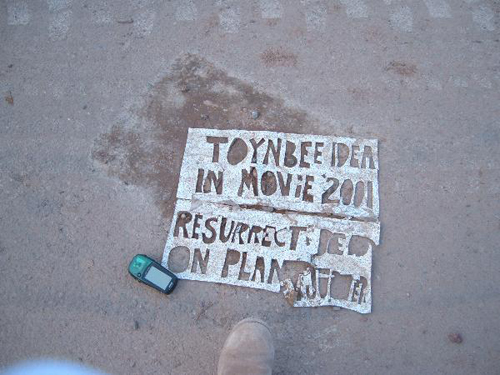
Posted on July 16, 2006
Toynbee tile in Iraq
 Here’s a photo of a Toynbee tile from Balad, Iraq… WTF?
Here’s a photo of a Toynbee tile from Balad, Iraq… WTF?
The copycat tile was discovered by a poster to this site.
Quote for posterity:
N 33° 57.131 E 044° 22.552
Cool! Balad (or thereabouts, Iraq)
How bored can you get while sitting around morking on the tan on the back of your hands and your nose it Iraq? Oh, let me count the ways . . .
The road is located near a dead end near the local contract utilities and mainetance shops.
Thanks for this interesting cache, history and a reference to Ray B
in faith, Johann Panholtz
Posted on July 2, 2006
Saturday Night Weirdness
Not long ago, a group of mad scientists gathered in a laboratory near Philadelphia and constructed a device that they claimed achieved 2-way communication with the dead. They asked for no money from these experiments and gave away all information on the construction of their communicators. One of these scientists, Hans Heckmann, is still alive and well. Because of his odd hobby and his day job as a Conrail engineer, he attracted the attention of the Toynbee tile documentary team. From what we have been able to tell, Heckmann stood firmly by his research. To him, it was not a fraud, it was very real and very serious.
Here is a recording that Heckmann and company made with their device. Following is a transcript and a link, but first a brief explanation of the quality of the recording:
…We have been told by our spirit colleagues that it is not an easy thing for them to speak into our world loudly and clearly in a voice that sounds natural and normal to us. When they come through our equipment, they somehow have to transduce the subtle energies of their world into electrical and acoustic energies of our world. They say they employ techniques and apparatuses in their world that are currently beyond our understanding.
Read the text below as you listen from this link.
“Finally, last but not least, Mark Macy. My dear friend, we bring our greeting to Colleague Meek and the Uphoffs. Also to Hans Heckmann with whom he realizes a beautiful job to spread ITC information. You know by experience, Mark, how dangerous drugs of all kinds can be. Try to warn humanity that they not only alter their present lives on your side, but also influence in a negative way their future lives. Go on with your experiences and you will see that the bridge to the States will soon be strengthened. Regina, as your twin soul, can help you a lot. Listen to her inner voice, and you will be in the right way.” “Thank you,” I said.
So this was:
A. A total fraud, or
B. Real.
That’s all for now.
